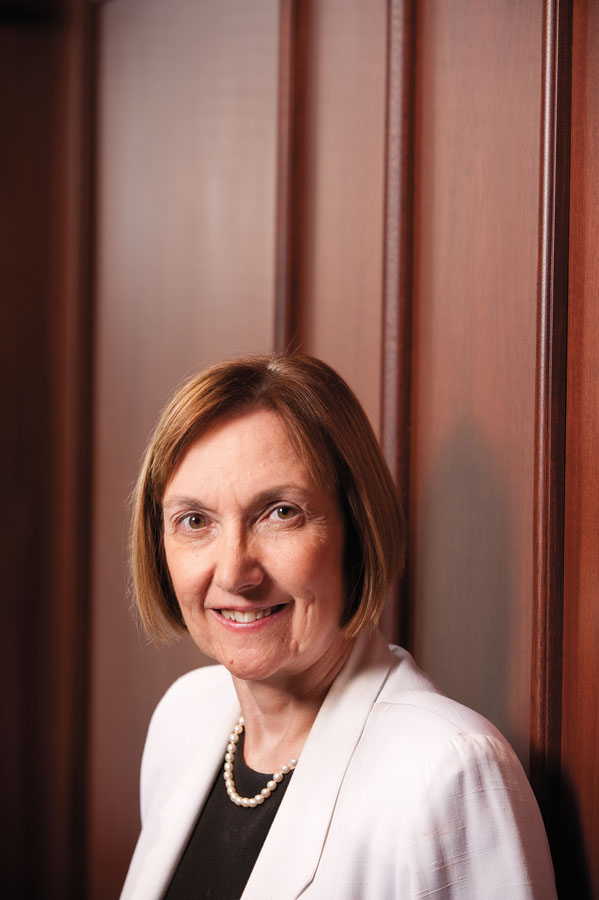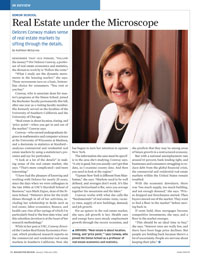In Review
 DRIVERS: “Real estate is about location, timing, and ‘price point,’ ” says Conway, who joined the Simon School as a professor of real estate economics and statistics. (Photo: Adam Fenster)
DRIVERS: “Real estate is about location, timing, and ‘price point,’ ” says Conway, who joined the Simon School as a professor of real estate economics and statistics. (Photo: Adam Fenster)Remember that old phrase, “Follow the money”? For Delores Conway, a professor of real estate economics and statistics, the dictum to work by is “Follow the rents.”
“What I study are the dynamic movements in the housing market,” she says. Those movements turn on a basic, bottom-line choice for consumers. “You rent or you buy.”
Conway, who is associate dean for master’s programs at the Simon School, joined the Rochester faculty permanently this fall, after one year as a visiting faculty member. She formerly served on the faculties of the University of Southern California and the University of Chicago.
“Real estate is about location, timing, and ‘price point’—when you get in and out of the market,” Conway says.
Conway—who earned undergraduate degrees in mathematics and computer science at the University of Wisconsin at Madison, and a doctorate in statistics at Stanford—analyzes commercial and residential real estate markets by using a statistician’s precision and eye for particulars.
“I look at a lot of the details” in making sense of the real estate market, she says. “That’s more complicated—and more interesting.”
“I have had the pleasure of knowing and working with Delores for nearly 25 years, since the days when we were colleagues in the late 1980s at USC’s Marshall School of Business,” says Mark Zupan, dean of the Simon School. “Delores’s drive for the truth shines through in all of her activities, including her scholarship in fields such as real estate, labor economics, finance, and health care. One of her sayings of which I'm particularly fond is ‘the best data wins,’ and this relentless devotion is at the heart of her research methodology.”
While in her post at USC, Conway directed the Casden Real Estate Economics Forecast, which produced research reports on the commercial and residential real estate markets in Southern California. Now she has begun to turn her attention to upstate New York.
The information she uses must be specific to the area she’s studying, Conway says. “A city is good, but you usually can’t get that data, so I examine county data. And then you need to look at the region.”
“Upstate New York is different from Manhattan,” she says. “Markets need to be well defined, and averages don’t work. It’s like saying Switzerland is flat, once you average together the mountains and the lakes.”
Conway works with what she calls the “fundamentals” of real estate: rents, vacancy rates, supply of new buildings, demand, and job growth.
For an upturn in the real estate market, she says, job growth is key. Health care and energy have seen steady employment growth through the recent recession, and she predicts that they may be among areas of future growth in a restructured economy.
But with a national unemployment rate around 10 percent, bank lending tight, and businesses and consumers struggling to reduce debt from the global financial crisis, the commercial and residential real estate markets within the United States remain troubled.
With the economic downturn, there was “too much supply, too much building, and not enough demand,” she says. “Prices dropped and foreclosures started. Then buyers moved out of the market. They want to find a floor in the market” before moving back in.
If rents hold, then mortgages become competitive investments, she says, and a floor in the market emerges.
“This should be an ideal time to buy,” she says. “Interest rates are really low, and there have been huge price declines. But people are holding back because there’s a lot of uncertainty. People are nervous about keeping their jobs.”

